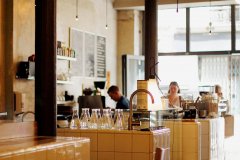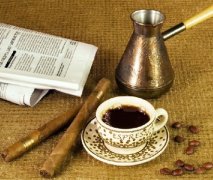Introduction to the method of treatment in producing areas for describing the Flavor of Columbia Linglong single Bean Flavor

For professional baristas, please follow the coffee workshop (Wechat official account cafe_style)
Colombia Colombia
Population: 47073000
Colombia has well-defined growing areas and the impressive variety of coffee they produce. Whether you want round, heavy coffee, refreshing, fruit-flavored (or somewhere in between), Columbia beans are most likely. Colombia is divided by geographical location, and it is not difficult to find that the coffee there has many common characteristics. If you like coffee in one area, other areas will like it as well. Coffee trees get double cropping in Colombia, the second main harvest and harvest each year, which is called "mitaca" locally.
CAUCA
CAUCA Cauca, best known for its coffee cultivation around Inza and Meseta de Popayan in Popayan, provides favorable growth conditions at high altitudes on the plateau and near the equator and surrounding mountains, which protects coffee from Pacific humidity and southern trade winds. This creates a very stable climate all the year round. In addition, coffee in the area has significant volcanic soil. According to historical records, there is a single rainy season from October to December every year.
Altitude: 1700-2100m
Harvest: March-June (major crops), November-December (mitaca crops)
TOLIMA
TOLIMA Tolima, one of the strongholds of Colombia's notorious rebel group Revolutionary Armed Forces of Colombia (FARC), until recently held control. Tolima has suffered from fighting in recent years, which makes the visit difficult. High-quality coffee from the region is grown by small farmers in very small areas and exported through cooperatives.
Altitude: 1200-1900m
Harvest: 3mer-June (main crop) crops October to December (mitaca)
Variety: 9% Typica 74% Catura 17% Castillo Villa
NARINO
Some of Colombia's highest quality coffee is grown in Narinho, which is arguably the most amazing and complex. Growing coffee in many areas of these high elevations is a challenge, and coffee trees are likely to suffer from leaf blight. However, Narinho is close enough to the equator that the climate is suitable for planting coffee trees. Most of Narinho's 40,000 producers are small farmers, each with a planting area of less than 2 hectares (4.4 acres). Many people form groups and institutions to support each other and interact with FNC. In fact, the average size of the farm is less than 1 hectare (2.2 acres), and only 37 producers own more than 5 hectares (11 acres) of land in the area.
Altitude: 1500-2300 m (4900-7500ft)
Harvest: April-June Variety: 54% Typica, 29% CaturraMagol, 17% Castillo.
HUILA
Wirat has an excellent combination of soil and geographical advantages for growing coffee, and some of the most complex and fruity Colombian coffees come from here. There are more than 70, 000 coffee growers in the area, covering more than 16000 hectares (39500 acres).
Altitude: 1250-2000m
Harvest: September to December (main crop) April to May (mitaca crop)
Main varieties: 11% Typica, 75% Catura, 14% Castillo.
To the west of Colombia is the Andes, which is divided into three parts: the western, central and eastern mountains. The Cauca and Magdalena rivers flow along the Caribbean to the lowland plains.
Colombia, currently the world's third largest coffee producer, uses washing to treat Arabica coffee beans. It is also one of the largest producers of high-quality coffee in the world. Traditional deep-roasted coffee has a strong and memorable flavor. Coffee was first introduced to Colombia in 1808, when it was brought by a priest from French Antilles via Venezuela. Today, the country is the third largest coffee producer after Brazil and Vietnam, with an annual output of 12 million bags of 60 kg each, while Brazil produces 31 million bags a year. The status of coffee in Colombia can be seen in the following examples: all vehicles entering the country must be sprayed and sterilized so as not to inadvertently cause disease and damage coffee trees.
The main producing areas are Huila (San Augustin), Narino, Tolima, Popayan (Cauca), Valle de Cauca, Meta, Antioquia (Medellin), Magdelena (Sierra Nevada), Boyaca, Santander (Bucaramanga) and so on. About 700 million coffee trees are documented in Colombia, 66% of which are planted in modern plantations and the rest in small, traditionally run farms. The main varieties include Kaddura Caturra, Colombia Colombia, Tibica Tipica, Bourbon Bourbon, Elephant Bean Maragogype, and Tabi. Farms and cooperatives throughout the country, big or small, are distributed in more than 500000 municipalities and 14 major coffee-producing areas. A total of 2 million Colombians depend on coffee cultivation for a living, contributing 12.5 per cent to gross domestic product. High-end Colombian coffee beans grow in the Andes at an altitude of 1200m and 2000m, and are planted between banana trees and rubber trees to provide shade for coffee trees.
Colombian coffee farmers can sell all their products to the Coffee Management Association at an official low price or to exporters, who may offer higher prices. In fact, the Coffee Management Association controls overall exports to Europe, while coffee to the United States is mainly exported through private exporters, however, all exports are controlled by the lowest export price.
Narino province is located in the southwest of Colombia, the whole territory is located in the highest region of Colombia, the provincial capital San Juan de Pasto faces Ecuador (Ecuador) and faces the Pacific Ocean. Coffee cultivation is a very important economic pillar for Na Linglong province, where traditionally the planting area of small coffee farmers is less than one hectare.
Most of the coffee growing areas in the province are alpine terrain belonging to the Andes, remote mountains, steep mountains, blown by the Pacific sea breeze, the provincial capital San Juan de Pasto. At the same time, Narino province is also one of the important coffee producing areas in Colombia. although its planting area is the smallest of the 14 large producing areas, the whole territory has the natural environmental conditions of special valley microclimate, so the coffee produced is of the best quality and has been known as the "Holy Grail of the Pope" since ancient times. Planting raw beans near the Ecuadorian border, about 1600m above sea level, on the cloud belt of 2300 meters, the environment is excellent, the soil is fertile, the harvest and treatment procedures are carefully complicated, and the quality is extremely high.
Kaddura Nalinglong Aponte Manor, Colombia (Colombia Nari ñ o Inga Aponte Caturra)
Country: Colombia (Colombia)
Producing area: Tabl ó n de G ó mez, Nalinglong province (Narino)
Producer: Aponte Manor (Inga Aponte)
Variety: Kaddura (Caturra)
Altitude: average 2150 m
Treatment: washing treatment
Flavor features: honey, flower scent, dark chocolate, red cherry, sweet sugarcane, cocoa
Na Linglong
Columbia Nalinglong producing area is located in the southeast of Colombia.
The Andes (Andes) at the junction with Ecuador
It begins in Chile and Argentina in the south, across the north and south of Colombia.
At the same time through the Nalinglong production area).
The natural geographical environment here: the tropical Pacific coast,
The Amazon Basin and the high Andes divide the Nalinglong producing area into three major topography.
The first is the plains along the Pacific coast, the second is the Amazon basin and then the Andes.
Nalinglong coffee producing area is produced by 37 cities in Nalinglong province.
Nalinglong producing area is near the equator at latitude 0 ℃
The number of sunshine hours received every day throughout the year is almost the same.
The average sunshine time is 1666 hours per year.
At the same time, the location and geographical environment of the producing area, the average annual temperature suitable for coffee growth,
Stable temperature changes in the morning and evening and annual rainfall
So that the coffee trees rich in soil organic matter in Nalinglong producing area can also thrive at very high altitude, which has a significant impact on the flavor and aroma of coffee.
Everyone's taste is not necessarily what they like.
You can consider buying a small amount and trying different baking degrees.
Soy beans in an explosion
Drop the beans at the end of the explosion.
Drop the beans from the end of the first explosion to the second explosion.
Touch the beans under the second explosion.
Put the beans into the second explosion for 10-15 seconds
The second explosion of dense beans
I hope you bakers can find a more favorite flavor.
Colombia. Na Linglong, from Narino province in southwest Colombia, is located in one of the many coffee producing areas in the Andes near the Ecuadorian border. It is a boutique coffee bean in the eyes of coffee lovers.
Manual selection for the best quality coffee and supremo grade beans whose particle size reaches or even exceeds 18 Screen can be marked with Narino Reserva Del Patron for shipment.
Important Notice :
前街咖啡 FrontStreet Coffee has moved to new addredd:
FrontStreet Coffee Address: 315,Donghua East Road,GuangZhou
Tel:020 38364473
- Prev

Introduction of Larez Yaoke Coffee single Bean Flavor description Variety planting Development History production area treatment method
Exchange of professional baristas follow the coffee workshop (Wechat official account cafe_style) Puerto Rico coffee in 1736, coffee trees were introduced from Martinique to Puerto Rico (Puertp Rico). Most of the early coffee was grown by immigrants from Corsica. By 1896, Puerto Rico ranked sixth in coffee exports in the world, and most of the coffee was shipped to France.
- Next

Guatemala Antigua Flower God single Bean Flavor description Variety planting Development History production area treatment method
For the exchange of professional baristas, please follow the coffee workshop (Wechat official account cafe_style) Guatimala Guatemalan population: 15438000 Guatemala has been more successful in defining its coffee priority areas than most countries and has developed its market with very different sales models.
Related
- Detailed explanation of Jadeite planting Land in Panamanian Jadeite Manor introduction to the grading system of Jadeite competitive bidding, Red bid, Green bid and Rose Summer
- Story of Coffee planting in Brenka region of Costa Rica Stonehenge Manor anaerobic heavy honey treatment of flavor mouth
- What's on the barrel of Blue Mountain Coffee beans?
- Can American coffee also pull flowers? How to use hot American style to pull out a good-looking pattern?
- Can you make a cold extract with coffee beans? What is the right proportion for cold-extracted coffee formula?
- Indonesian PWN Gold Mandrine Coffee Origin Features Flavor How to Chong? Mandolin coffee is American.
- A brief introduction to the flavor characteristics of Brazilian yellow bourbon coffee beans
- What is the effect of different water quality on the flavor of cold-extracted coffee? What kind of water is best for brewing coffee?
- Why do you think of Rose Summer whenever you mention Panamanian coffee?
- Introduction to the characteristics of authentic blue mountain coffee bean producing areas? What is the CIB Coffee Authority in Jamaica?

